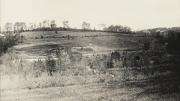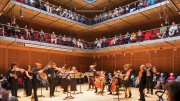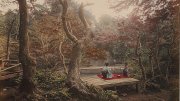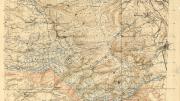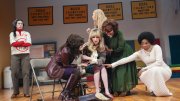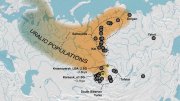“It smells like cake,” says the Arnold Arboretum’s keeper of the living collections, Michael Dosmann, standing beneath a nearly 150-year-old Japanese katsura tree. Its dark, curvy limbs are surrounded by a halo of delicate red leaves worthy of a pointillist painting. On one side of the tree are a marsh and a busy parkway, and on the other, the Arnold Arboretum: 281 acres of curated forest and fields, home to about 16,000 woody plant specimens in its permanent collections. Dosmann—sporting a blue blazer, button-down, and Converse sneakers—exudes the kind of bouncing-on-his-heels energy that only a person who loves his job could. “No, really, it does,” he says, patting a branch. “The katsura’s leaves smell like cake. Or like, a burnt brown sugar, cotton candy kind of smell.”
The seeds that gave rise to this delightfully scented katsura (Cercidiphyllum japonicum) arrived at the newly established Arnold Arboretum in 1878, in an envelope postmarked from Japan. Peat-brown, no bigger than a nickel, and shaped like edamame, the pods had been plucked from trees in Sapporo by scientist William S. Clark and delivered to his friend, the Arboretum’s founding director Charles Sprague Sargent. The seeds were placed under the care of the Arboretum’s only full-time employee, plant propagator Jackson Thornton Dawson—a plantsman’s plantsman who resembled Santa Claus with a handlebar mustache. He brought one fledgling katsura to life and planted it on the Arboretum’s grounds. This year, as the Arnold Arboretum celebrates its 150th anniversary and its status as the oldest public arboretum in the United States, that all-grown-up katsura stands as a piece of living history.
The Arnold Arboretum was established at a moment when Americans were hungry for nature. As the nation industrialized and urbanized, people looked for ways to escape the shadows of buildings and the smoke of factories. Cities like New York and Boston built public parks in response, and citizens brought the outdoors in, too. They rooted around in tidepools for fish to add to their new at-home aquariums and kept “cabinets” of unusual natural relics in their homes. There were even entire social groups dedicated to building cabinets. One Boston organization boasted one containing, among other oddities, 33 “bird-skins” and a handful of fish scales from Calcutta.
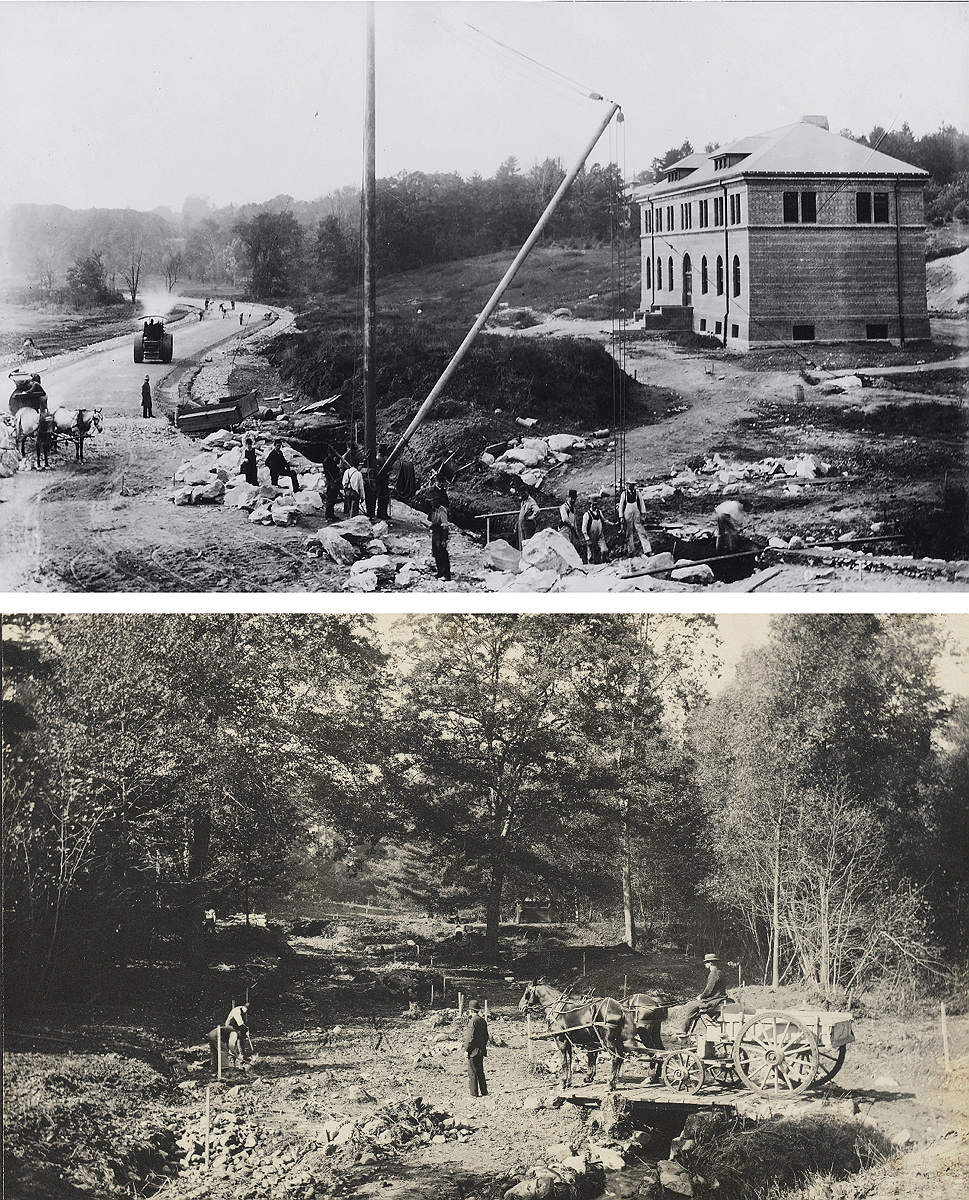
Built on what was once a family estate, the Arboretum was developed by teams of workers. The Hunnewell Building under construction in 1892; building a road near Hemlock Hill with the help of a work crew and a horse and cart
Photographs courtesy of the Arnold Arboretum Archives/ ©President and Fellows of Harvard College
Despite growing public interest, horticulture and botany were a rich man’s hobby in the later-nineteenth century. The world’s first arboretum, established in Derby, England, was intended to change that. It was open to people of all classes and designed to be more than just pleasant public green space. Instead, the arboretum was a “living museum,” curating a collection of woody plants intended for both academic study and public enjoyment. Housing trees from around the world in one place made it possible for botanists, horticulturalists, and members of the public to see and research plants they would never encounter otherwise. An arboretum was the point of intersection between science and beauty.
The concept crossed the Atlantic in 1872, when Harvard used a $100,000 bequest from whaling merchant James Arnold to establish the Arnold Arboretum on land from the Jamaica Plain estate of Benjamin Bussey, a wheeler-and-dealer who’d made a fortune in everything from silversmithing to importing merino sheep. The University appointed Sargent—a scion of old Boston Brahmin stock who’d found his life’s work in botany after serving as a major in the Union Army—as director. Although he was reserved to the point of coldness, Sargent, College class of 1862, was a passionate conservationist who worked closely with John Muir to further the American national parks movement.
Coupling Sargent’s energy and connections with design expertise, Harvard appointed Frederick Law Olmsted, A.M. 1864, LL.D. ’93, the landscape architect for Central Park, to design the Arboretum. The University saw the Arboretum as an ideal research ground—one where scientists could study trees and introduce hybridized varieties into wider cultivation—but Olmsted knew it was also a necessity for the urban public. He wrote in one letter: “We want a ground to which people may easily go after their day’s work is done, and where they may stroll for an hour, seeing, hearing, and feeling nothing of the bustle and jar of the streets, where they shall, in effect, find the city put far away from them.”
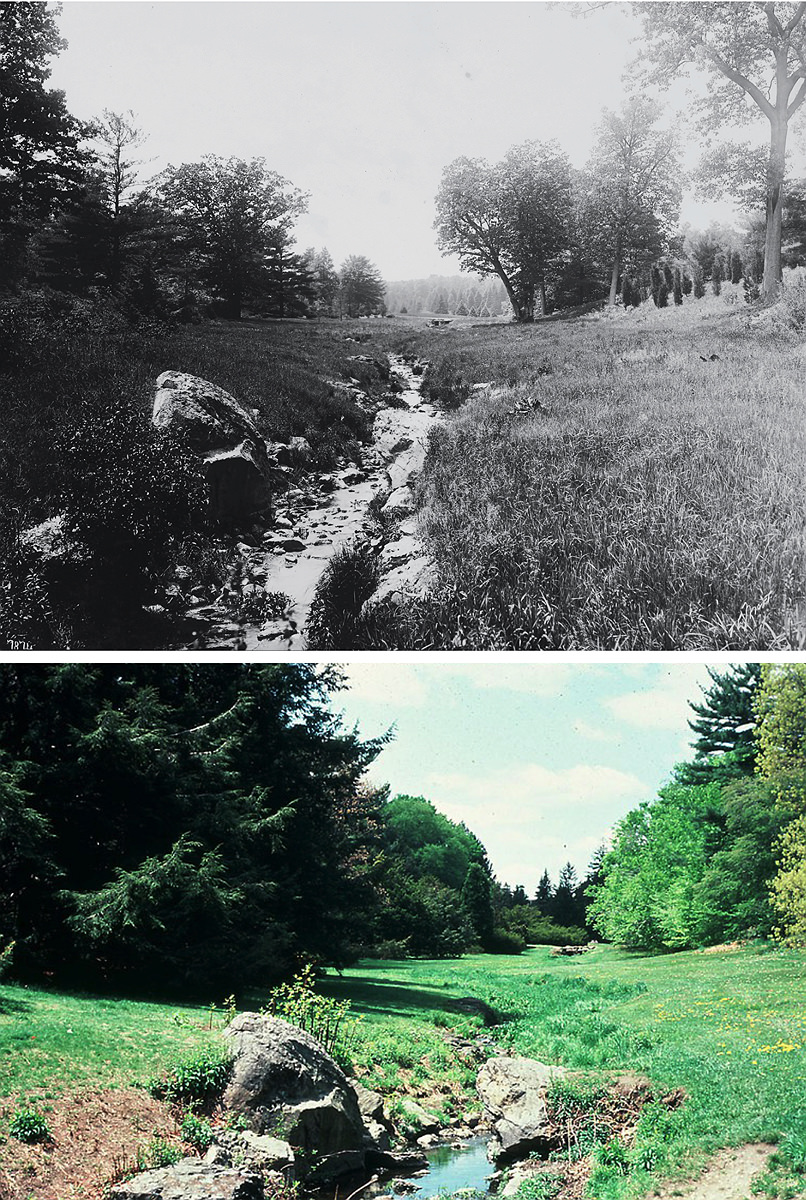
Though the Arboretum has changed, some photographs highlight its continuity, such as this spot at Bussey Brook facing the Conifer Collection, pictured above in 1903 and below in 1970.
Photograph courtesy of the Arnold Arboretum Archives/ ©President and Fellows of Harvard College
Even though the trees and shrubs were arranged taxonomically to facilitate scientific study, Olmsted created the illusion of wilderness. “An arboretum is, in a sense, a piece of artwork and a museum,” says current director William “Ned” Friedman, Arnold professor of organismic and evolutionary biology. “You can’t just put the trees in rows like a Christmas tree farm. Instead, you plant in such a way that the landscape and the trees create and actually shape your experience.” Olmsted’s naturalistic design concept caught on. Other arboreta slowly cropped up around the United States throughout the twentieth century, all modeled after the Arnold—its staff even consulted on several, including the Morton Arboretum in Chicago (named after the Morton salt magnates).
It took a team of Irish, German, and Italian immigrants to build the Arnold. “All of the work was done by hand,” says Lisa Pearson, the Arboretum’s head of library and archives. “There were horses and carts, but for the most part, it was men with pickaxes.” The horses and carts belonged to a man known in Sargent’s record books only as “Mr. Daley,” who brought his rigs to move dirt and trees around the Arboretum as needed. Pearson says, “Today, you could just rent a front-end loader.”
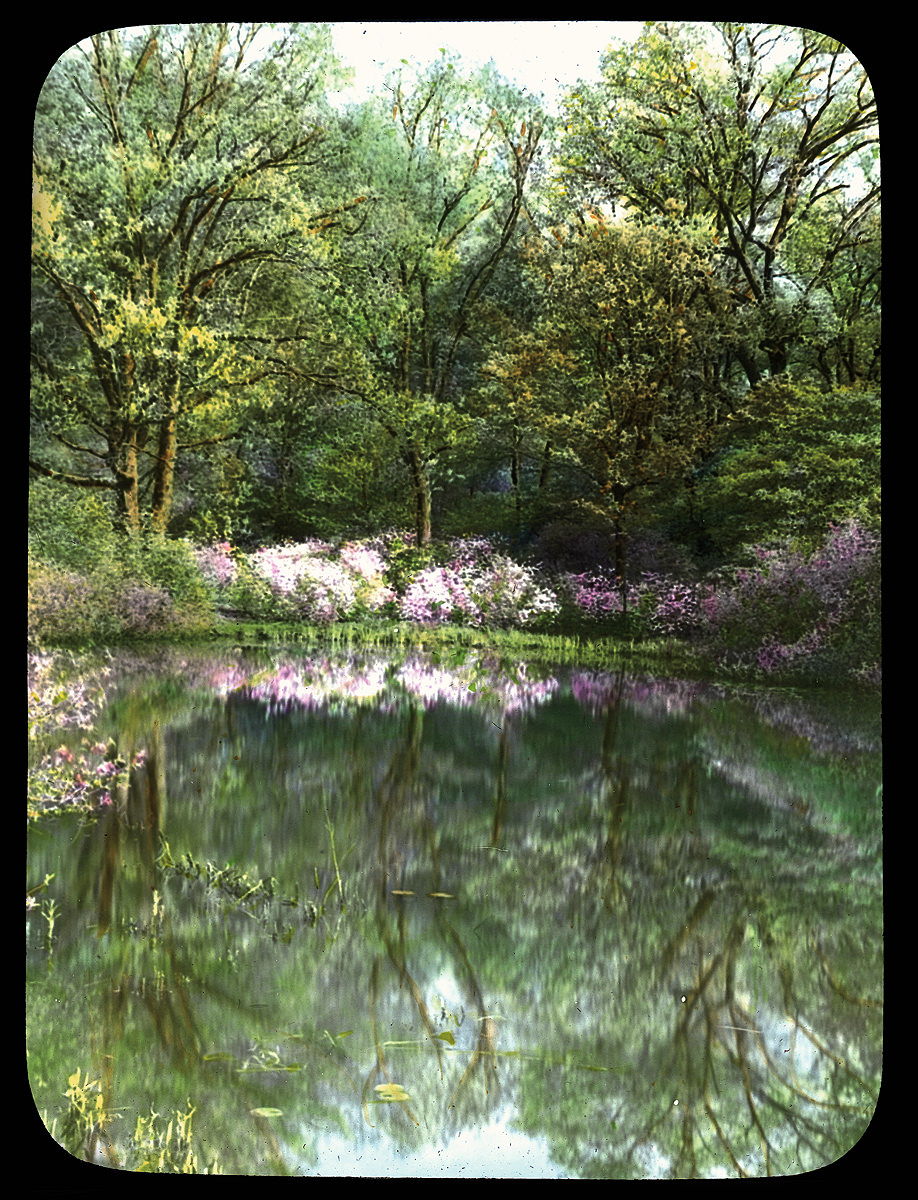
Pinkshell azaleas (Rhododendron vaseyi) bloom circa 1920, their flowers reflected on the surface of Faxon Pond.
Photograph courtesy of the Arnold Arboretum Archives/ ©President and Fellows of Harvard College
All this construction required funds, and Sargent and Olmsted realized they’d need more of them. They approached the city of Boston in 1882 with a proposal: the land of the Harvard-owned Arboretum would become part of the Boston city parks system. The Arboretum would keep the grounds free and open to the public, from dawn to dusk 365 days per year, if in exchange the city maintained the roads and gates and provided surveillance. As director Friedman put it: “It’s Boston’s dirt, but it’s Harvard’s trees, and we manage the property.”
When Boston signed the agreement in the late 1800s, it wasn’t just for that century: the lease states that Harvard and Boston will operate the arboretum for 1,000 years, renewable once, for a total of two millennia. If Boston is still a city and Harvard is still a university in 3882, there will still be an Arnold Arboretum.
Thanks to the support of this public-private partnership, the Arnold is also Boston’s only free major cultural institution. Public access, Pearson says, has been “part of our DNA from the beginning.” For an organization to last through centuries as the Arboretum is intended to, maybe it needs something like institutional DNA, some tangible threads running through every aspect of its operations and guiding its evolution.
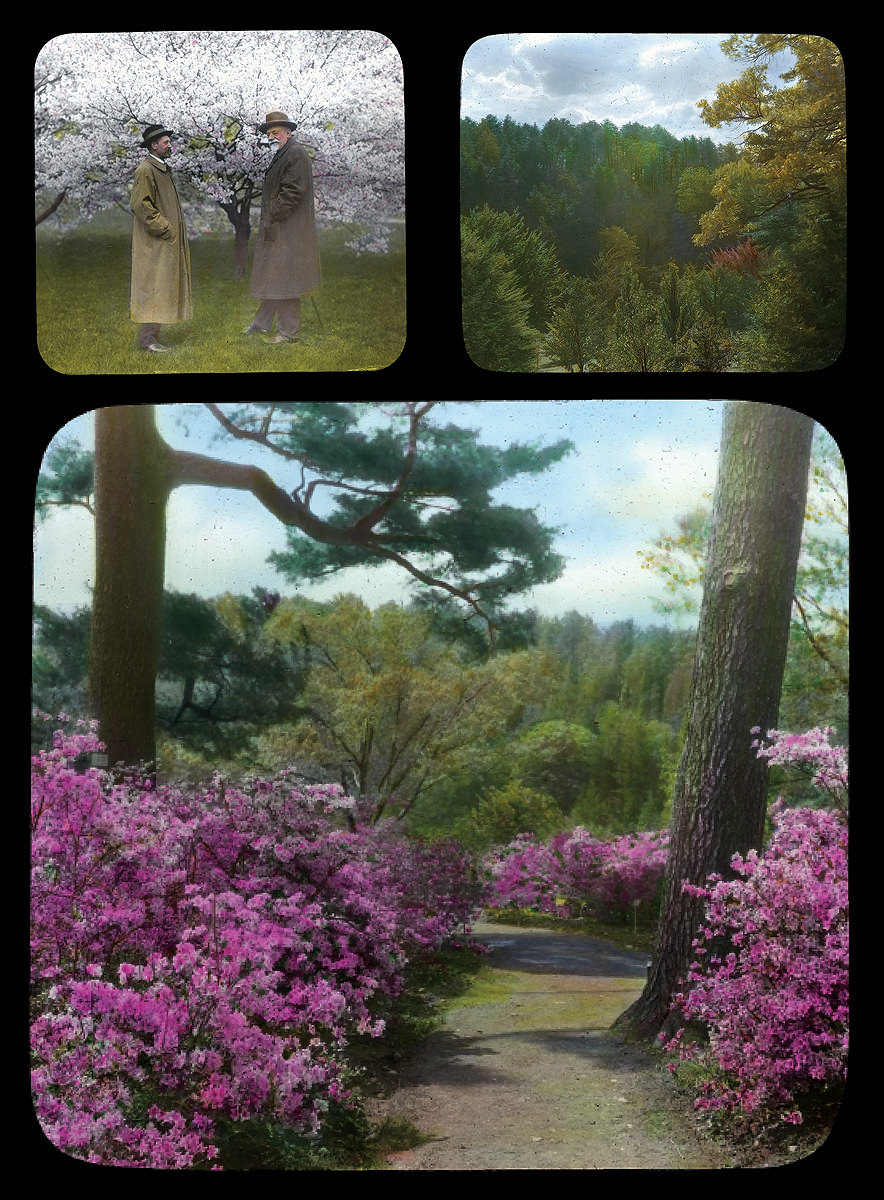
Clockwise from top left: director Charles Sprague Sargent and plant-explorer Ernest Henry Wilson in front of a Higan cherry tree (Prunus subhirtella) in May 1916; Azalea Path in 1928; Hemlock Hill in fall, c. 1920
Photographs courtesy of the Arnold Arboretum Archives/ ©President and Fellows of Harvard College
One of those threads is finding and preserving previously unknown species. Ever since the Arboretum opened its gates to Boston, it’s also kept an eye toward the rest of the world. Beginning in the early twentieth century, the Arboretum sent plant explorers to east Asia, a region celebrated for its biodiversity, to collect woody plant species unknown to western science. As those new species found a home at the Arboretum, Bostonians who perhaps had never seen anything besides red maples and elms learned about Japanese lilacs, katsuras, and the paperbark maple (Acer griseum), whose bark peels off like pencil shavings. And thanks to the Arboretum, they could even grow them at home, too. In keeping with its horticultural mission, the Arnold gave cuttings and seeds of successful new species to nurseries, increasing North America’s biodiversity and beautifying its suburbs’ gardens.
The relationship between the Arboretum and Asia even brought a “living fossil” to Boston. In 1948, after the tree was discovered in central China virtually unchanged from its fossil record, headlines about the dawn redwood tree (Metasequoia glyptostroboides) were “peppered and salted all over the newspapers,” says Dosmann. He adds, “It’d be like if somebody discovered a woolly mammoth alive right now.” (Unlike the woolly mammoth though, the dawn redwood is now grown all over the United States, due in large part to the Arboretum.) Geopolitics sometimes put a damper on the Arnold’s ability to collaborate with other countries (“Those world wars did cut into things a bit,” says Pearson), but almost always, botanical exchange prevailed. In 1980, for instance, the Arboretum took part in the Sino-American Plant Expedition, the first time that western botanists had been invited into China since the Chinese Communist Revolution in 1949.
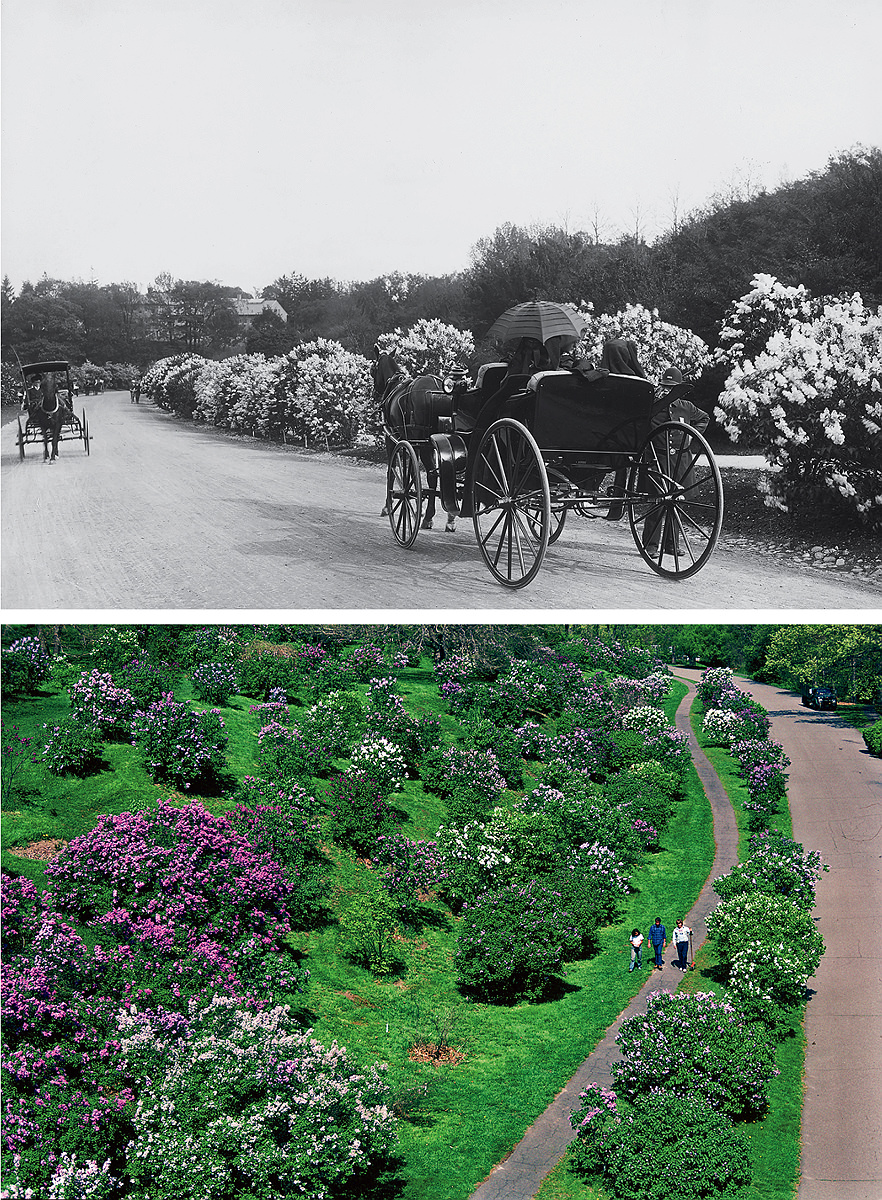
Horse-drawn carriages driving past blooming lilacs in 1908 (above); the same path in 1981 (bottom)
Photographs courtesy of the Arnold Arboretum Archives/ ©President and Fellows of Harvard College
Now, in an era of accelerating habitat loss and climate change, Arboretum-directed plant exploration aims less at discovering new species and more toward conservation. “There are things we’re collecting now and they’re secure in nature,” Dosmann says. “In 25 or 50 years, even 10 years, they might not be.” The Arboretum is already home to a species extinct in the wild: the Franklin tree (Franklinia alatamaha), named after Benjamin Franklin and once native to the American South. Senior research scientist emeritus Peter Del Tredici says, “If it weren’t for gardens, they wouldn’t exist.”
Other species in the Arboretum’s collection are endangered in the wild, like the cedar of Lebanon (Cedrus libani), a whimsical tree that resembles a giant green umbrella. Now, its native Lebanon is getting too hot for it, says Dosmann. “I mean, think about that. The cedar of Lebanon. It’s on their national flag. And that species is threatened with extinction.” Some specimens in the Arboretum are even more threatened, with only a handful of plants still growing in the wild. In a nod to both its history of plant collection and the reality of endangered species, the Arboretum has launched a campaign to acquire roughly 400 different types of plants, many endangered, from around the world during the next 10 years (see “The Plant Prospectors,” July-August 2016, page 37, and “Botanizing in the ‘Mother of Gardens,’” January-February 2018, page 32). “If we bring seed back and grow it safely at the Arboretum, called ex-situ conservation, we can keep the genetics alive,” says Friedman. “We can make sure that people who want to study these plants can study them.” And they can share those seeds with other arboreta so other parts of the world can enjoy them, too.
“With other museums, there’s only one Mona Lisa, but for us as a living museum, we can propagate it, we can cut it,” says curator Dosmann. Perhaps unlike an art museum, the Arboretum has a vested interest in sharing its material: “If you don’t give it away to somebody, if you were hoarding that Mona Lisa and something happened to it, you’d never get it back.” And “something” can, and does, happen to these trees. Unlike Boston’s Museum of Fine Arts, the Arboretum can’t adjust its temperature or humidity controls to preserve the artwork. Events like the 1938 hurricane can swoop in overnight and take out 1,500 trees, or the 1997 April Fool’s Day storm can obliterate spring blossoms with snow as heavy as concrete.
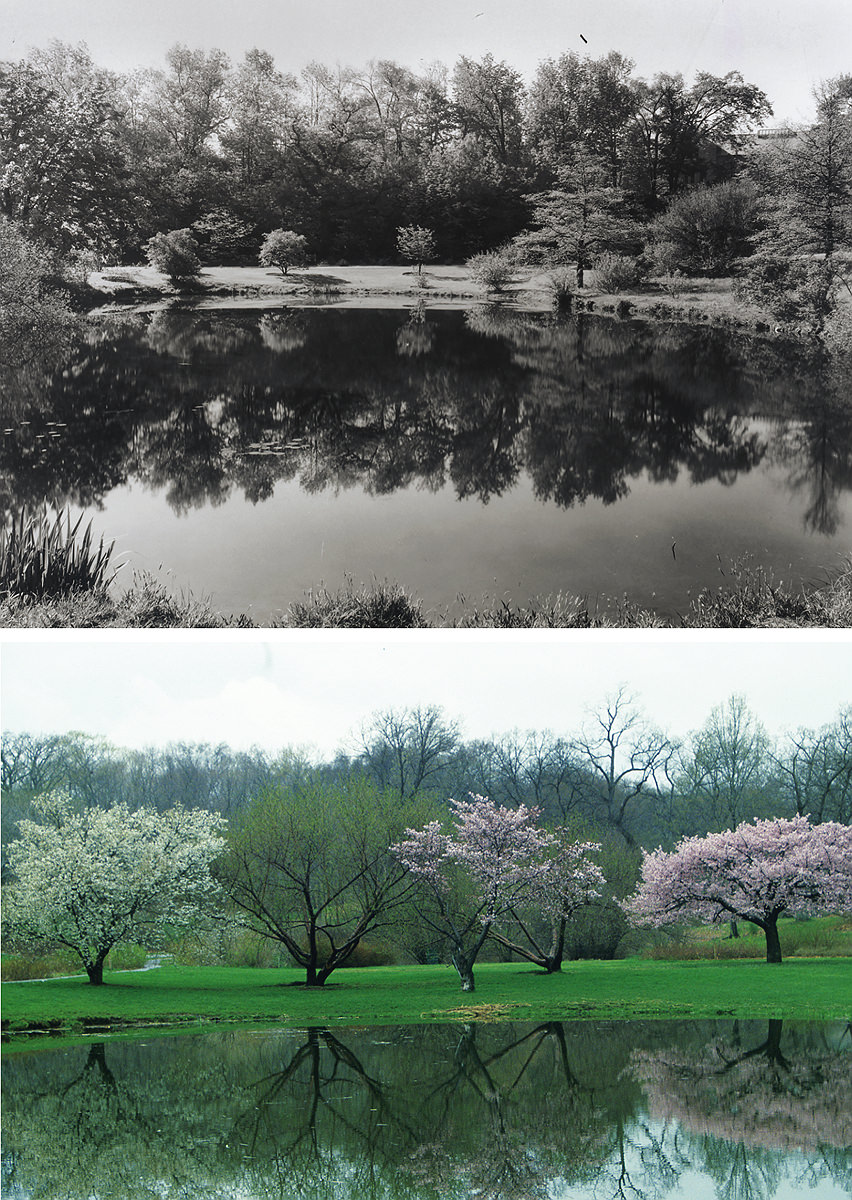
Dawson Pond in 1929 (above) and the same spot again in 1982 (left)
Photograph courtesy of the Arnold Arboretum Archives/ ©President and Fellows of Harvard College
Weather patterns are even more unpredictable now, Friedman says. One study at the Arboretum found that its trees are flowering about eight days earlier than they were a century ago, a sign of warming temperatures. “Our climate controls are the planet, and they’re broken, right?” he says. “So, we’ve got to figure out how to grow our plants for the next century, for your descendants, in an ever more challenging set of climate extremes.”
Preserving this living museum for the next generation is perhaps the most important part of its mission. Friedman believes that by walking among the Arboretum’s trees, many of which were planted before their great-grandparents were alive, visitors can “cultivate respect for something other than themselves.” Stewarding the Arboretum is an act of selflessness, he says. “Unlike a botanical garden where lots of stuff grows fast, in an arboretum, you’re always paying it forward.” Because some trees can take 50 or 75 years to reach maturity, Friedman, Dosmann, and the rest of the current Arnold staff will never see the full result of their work. With about 1,850 years left on the Arboretum’s lease, the 150-year-old collection is only in its infancy.
When Friedman envisions the next 150 years at the Arnold and the millennia beyond, he thinks of the Arboretum staff planting that katsura tree in 1878. “Olmsted designed everything, but he never saw it. He saw young trees, but he never saw what we’re seeing. He designed what you’re seeing now, for you, in the 1880s,” he says. Time moves slowly in the Arboretum, but it’s closely connected. “One hundred years from now, one of your grandchildren will be standing under a magnolia tree we collected as seed in 2019,” Friedman says, or it could be a red maple, a Japanese lilac, or a cedar of Lebanon. Or maybe it will be a katsura tree, and the grandchild will say it smells like cake.
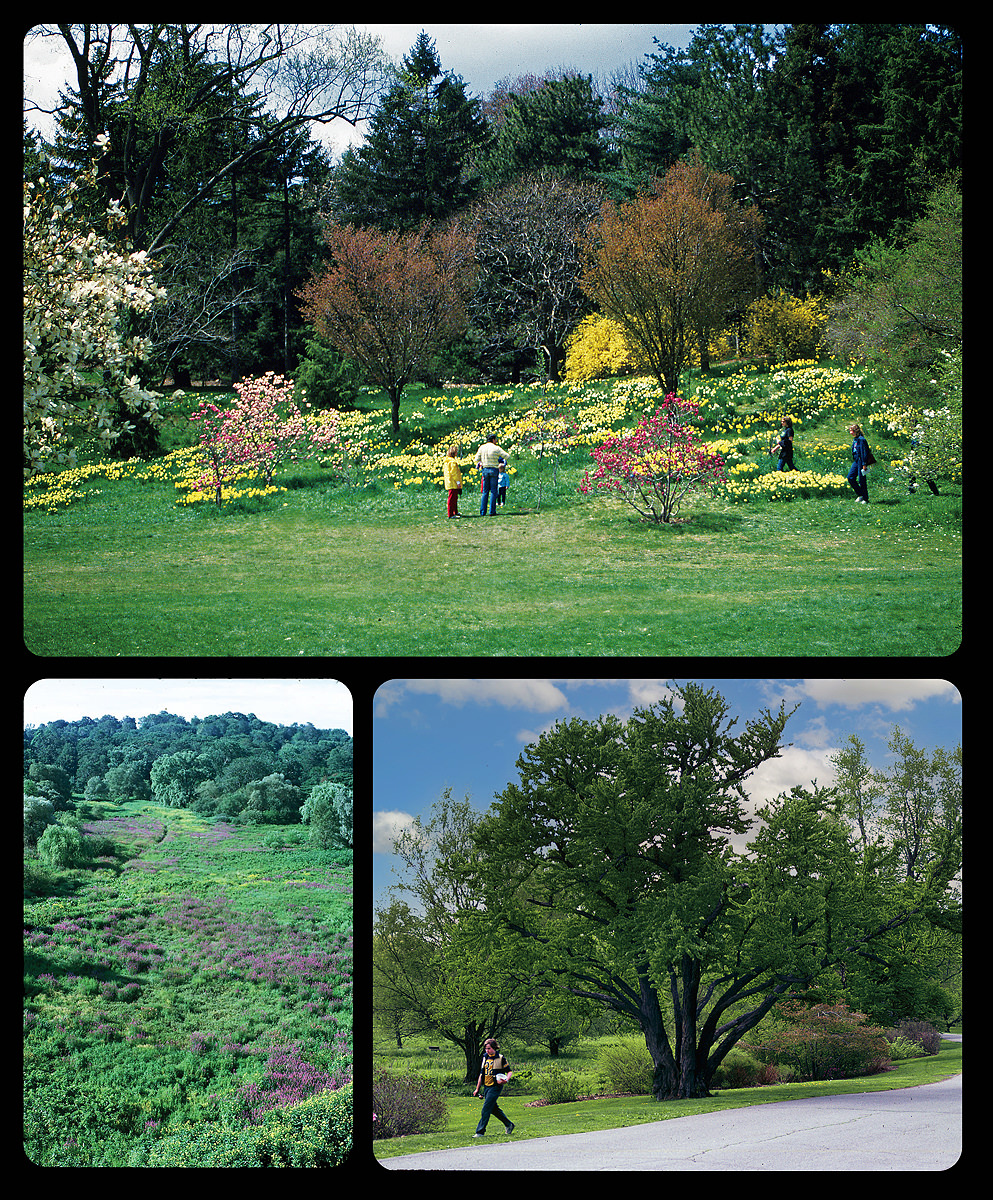
Clockwise from left: People meander among the narcissus near the Hunnewell Building; North Meadow in summer, 1972; the 104-year-old katsura tree in 1982
Photographs courtesy of the Arnold Arboretum Archives/ ©President and Fellows of Harvard College
